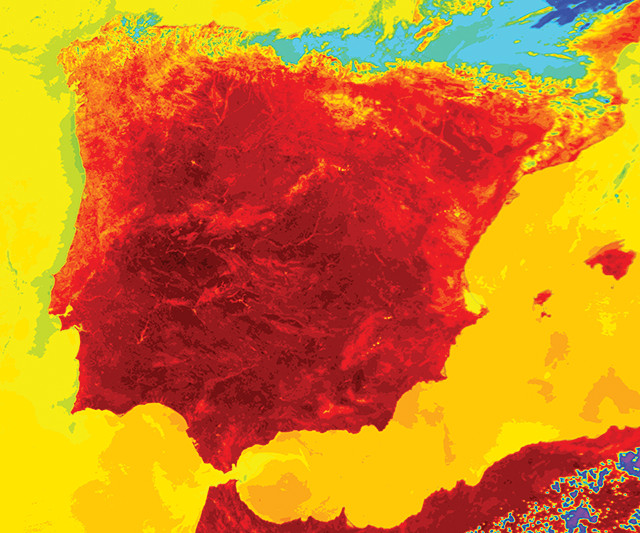
by Terri Cook Friday, April 1, 2016

Land-surface temperatures, as shown in this false-color NASA MODIS image taken on July 1, 2004, were as high as 59 degrees Celsius during a blistering heat wave over the Iberian Peninsula, while "dry-bulb" air temperatures reached up to 40 degrees. New research suggests that many densely populated parts of the planet will be subjected to "crippling" heat stress by midcentury. Credit: NASA Goddard Space Flight Center.
Extreme heat events, defined by the U.S. Environmental Protection Agency as periods of summer weather that are substantially hotter and/or more humid than is typical for a given location and time, can cause heat stress. Heat stress, an illness that occurs when the body is unable to cool itself via sweating, can lead to cramps, heat exhaustion and — at its most severe — heat stroke, a potentially fatal condition.
As the planet continues to warm, extreme heat events in some locations are predicted to become more frequent and more severe, and to last longer. Most studies of heat stress related to ongoing climate change have focused solely on air temperatures. But when considering its impacts on people, it’s also important to take humidity into account, says Ethan Coffel, a doctoral student at Columbia University who, along with his Columbia-affiliated colleagues Radley Horton and Alexander de Sherbinin, presented research looking into the future effects of heat stress on densely populated regions at the fall meeting of the American Geophysical Union (AGU) in San Francisco last December. When relative humidity is low, the evaporation of sweat, and hence a human’s built-in cooling system, is quite efficient, Coffel says. But as humidity rises, “the ability of people to cool themselves declines quite rapidly.”
Heat stress can be measured by several indices, including the conventional heat index, which factors in temperature and humidity. But the scale that Coffel and his colleagues focused mainly on was “wet-bulb temperature,” which “can be thought of as a measure of the efficiency of evaporation,” Coffel says. In addition to temperature and humidity, wet-bulb temperatures account for wind speed, cloud cover and the position of the sun.
It has often been assumed that people will be able to adapt to any realistic amount of global warming. But in 2010, researchers from the University of New South Wales in Australia published a paper that calculated a “peak heat stress” of 35 degrees Celsius on the wet-bulb temperature scale. This is a “theoretical limit for human tolerance to heat stress,” Coffel says.
In the current climate, dry-bulb temperatures — the scale familiar to most of us that only accounts for air temperature — often climb above 35 degrees Celsius. But wet-bulb temperatures of 35 degrees or higher are “basically unheard of,” Coffel says. Recent heat waves in Russia in 2010 and the Middle East, India and Pakistan in 2015 produced wet-bulb temperatures of 29 to 31 degrees — well below the threshold, but high enough to cause many deaths as well as “dramatic impacts” on human health, infrastructure, economic performance and agriculture, he says.
By combining population data from the Shared Socioeconomic Pathways Project with climate models, the team projected daily maximum wet-bulb temperatures globally through 2070. The results indicated that, by midcentury, what the team calls “crippling summertime conditions” could spread to some of the planet’s most densely populated regions. The main regions at risk are India, the Middle East and West Africa, areas where air conditioning is scarce, the capacity to adapt is low, and populations are rapidly increasing, Coffel says.
By the 2060s, Coffel and his colleagues concluded, hundreds of millions of people in these areas could potentially be exposed to wet-bulb temperatures of up to 33 degrees Celsius — conditions that could make working outdoors difficult or impossible. Another concern is the potential impact of high heat stress on ecosystems. Large mammals may be particularly vulnerable, although more research is needed in this area, Horton says.
By the end of the 21st century, the team wrote in their AGU abstract, “the habitability of some regions of the planet may be questionable due to heat stress alone.” Heat stress must be taken into account when planning for climate adaptation, the authors say.
“What these authors have done is a considerable step forward … in terms of how they’ve integrated moisture and temperature together, " says Noah Diffenbaugh, a climate scientist at Stanford University who was not associated with the study. “This is a case where the authors have really targeted the most immediate and the most acute interface between climate and people, and I think that highlights where we need to go in terms of our understanding of climate impacts.”
© 2008-2021. All rights reserved. Any copying, redistribution or retransmission of any of the contents of this service without the expressed written permission of the American Geosciences Institute is expressly prohibited. Click here for all copyright requests.